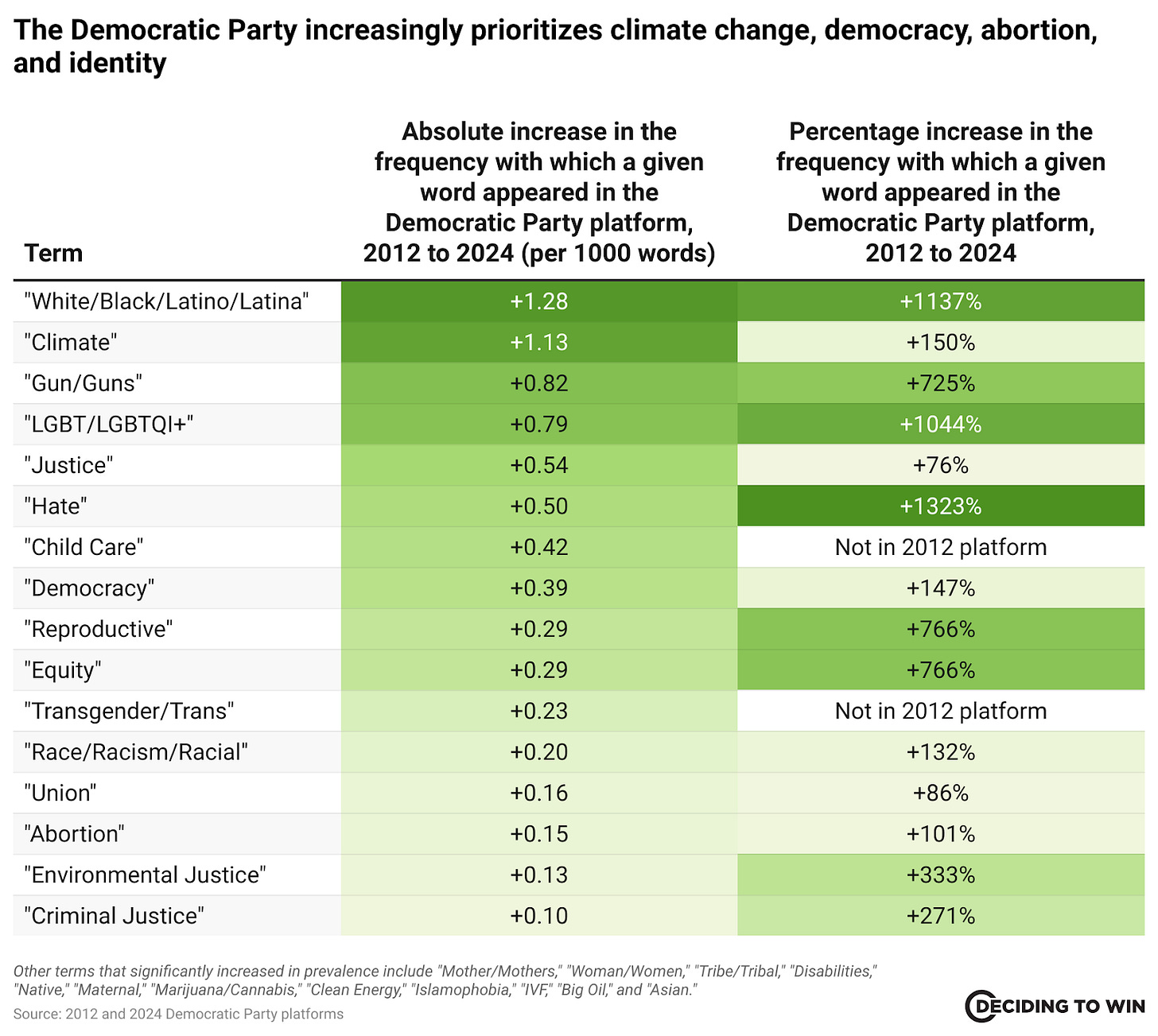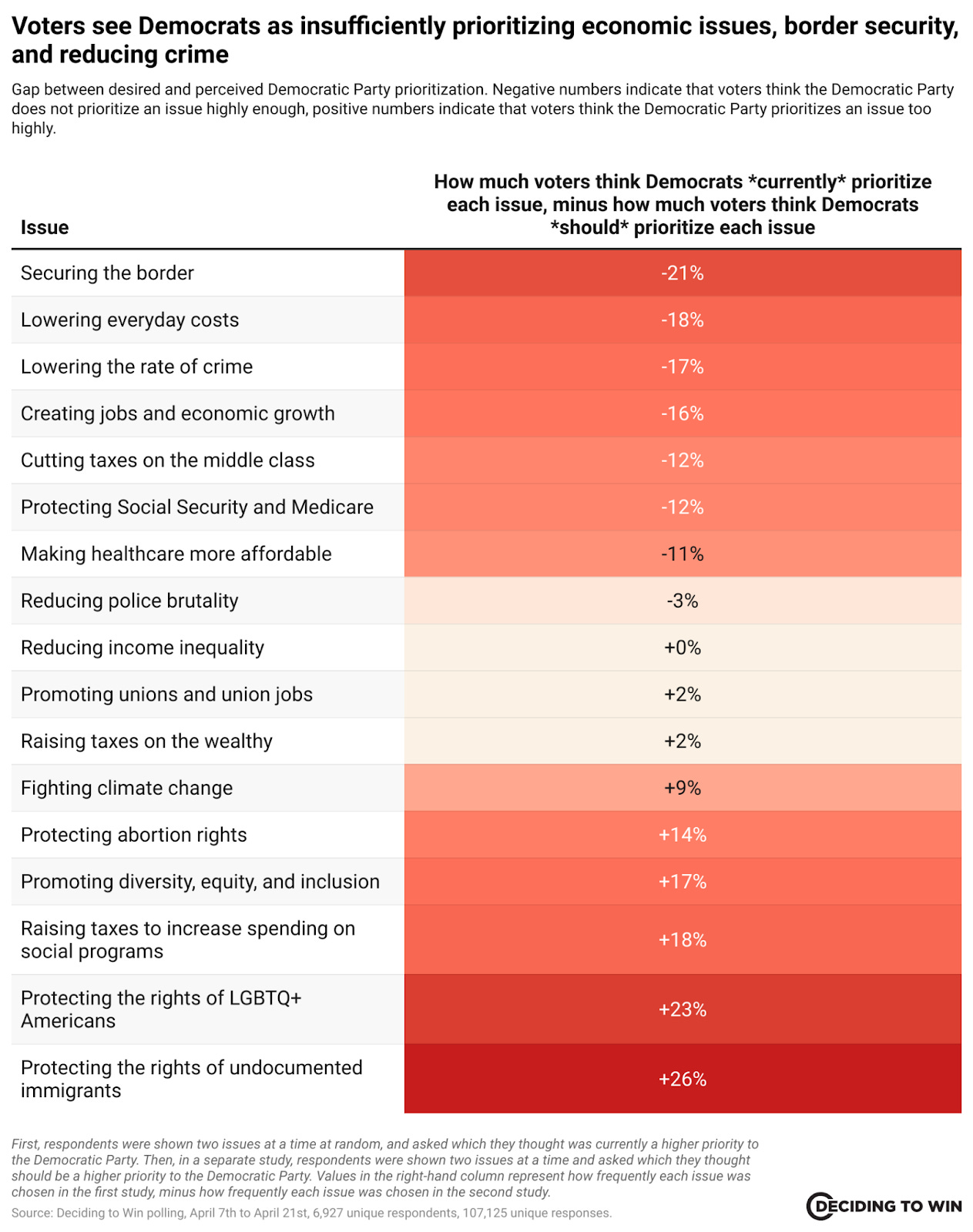DECIDING TO WIN: How We Got Here
An analysis of the Democratic Party platforms from 2012 to 2024 gives us clues to the current Democratic Party struggles
Our first video in the Deciding to Win series summarizes how we got here: how the Democratic Party of the early 2010s went from winning in states like Florida, Ohio, and Iowa and having U.S. senators in North Dakota, Montana, Missouri, and West Virginia to pundits now warning of a permanent Republican majority in the Senate.
So, what’s changed?
In 2012, the Democratic Party platform focused relentlessly on jobs and the middle class. Obama’s message? Rebuild the economy from the middle out, not the top down. Obama and his allies centered attacks on Mitt Romney’s approach to entitlement programs and treatment of workers.
On issues like immigration, Obama often broke with progressive advocates, and millions of illegal immigrants were deported during his tenure. At the time, this marked a record high for deportations in U.S. history, earning Obama the nickname “Deporter-in-Chief.”
The 2012 Democratic Party platform led with this:
Today, our economy is growing again, al-Qaeda is weaker than at any point since 9/11, and our manufacturing sector is growing for the first time in more than a decade. But there is more we need to do, and so we come together again to continue what we started. We gather to reclaim the basic bargain that built the largest middle class and the most prosperous nation on Earth - the simple principle that in America, hard work should pay off, responsibility should be rewarded, and each one of us should be able to go as far as our talent and drive take us.
The 2024 Democratic Party platform leads with:
The Democratic National Committee wishes to acknowledge that we gather together to state our values on lands that have been stewarded through many centuries by the ancestors and descendants of Tribal Nations who have been here since time immemorial. We honor the communities native to this continent, and recognize that our country was built on Indigenous homelands. We pay our respects to the millions of Indigenous people throughout history who have protected our lands, waters, and animals.
You have to read down to the fourth paragraph of the 2024 platform to get to the first policy-substantive lines of text, which read:
Our nation is at an inflection point. What kind of America will we be? A land of more freedom, or less freedom? More rights or fewer? An economy rigged for the rich and powerful, or where everyone has a fair shot at getting ahead? Will we lower the temperature in our politics and come together, or treat each other as enemies instead?
The section headers in the 2012 Party platform also stand out: “Rebuilding Middle Class Security,” “Cutting Waste, Reducing the Deficit, Asking All to Pay Their Fair Share,” “21st Century Government: Transparent and Accountable,” and “Ensuring Safety and Quality of Life.”
If you compare the full text of the 2012 and 2024 Democratic Party platforms, words that increased in use the most were: Black, White, Latino/Latina, climate, LGBTQ, transgender, and environmental justice.
The words declined in use the most between 2012 and 2024? Economy, jobs, middle class, men, crime, fathers, and tax cuts.
And it’s not just the emphasis and language that has changed since 2012. Here’s how Democrats talked about deportation in their 2012 platform:
The Department of Homeland Security is prioritizing the deportation of criminals who endanger our communities over the deportation of immigrants who do not pose a threat, such as children who came here through no fault of their own and are pursuing an education.
In 2012, Democrats were distinguishing themselves from Republicans based on who Democrats deport: criminals, versus immigrants who don’t pose a threat.
But here’s how Democrats talked about deportation in 2024:
President Biden has also taken steps to preserve and expand Temporary Protected Status (TPS) for individuals from countries experiencing armed conflicts, natural disasters, or other crises, giving thousands authorization to live and work in the United States without fear of deportation for a temporary period.
In 2024, Democrats distinguished themselves from Republicans based on their willingness to deport people at all.
And voters noticed.
The result of moves like this is shown in the chart below: Democrats are increasingly (correctly) perceived as more liberal.
The platform changes are also reflected in what voters perceive Democrats to be prioritizing.
While voters want to see Democrats prioritize cost of living, middle class issues, and healthcare, they believe Democrats are focused on protecting undocumented immigrants, LGBTQ issues, and raising their taxes.
So the real question here is, why the change? The 2012 Democratic platform worked to reflect the views of the average American. And if you asked the average Democratic voter if they believed the 2012 platform was too conservative on immigration, few would.
We’ve shifted from the 2012 platform to the 2024 platform because the Democratic Party has been overtaken by an activist class that works to advance the priorities of progressives – not the sentiments of the median voter.
Deciding to Win means turning down the volume of (and tuning out) activists and staffers to instead focus on what the voters believe. We hope you’ll join us in doing just that.








Unfortunately, Obama contributed to the leftward shift in his second term. He blamed the war on drugs for mass incarceration, even though state and local prisons (which held the vast majority of American prisoners) held far more people convicted of violent and property crime than drug crime. Cancelling Keystone XL was a mistake, as was federal officials saying anything whatsoever about transgender students and bathrooms.
A couple of requests for future iterations: (1) How much decline in references to "rural" and "farmers"? (2) Disentangle the LGB from TQ to get better data on public opinion.